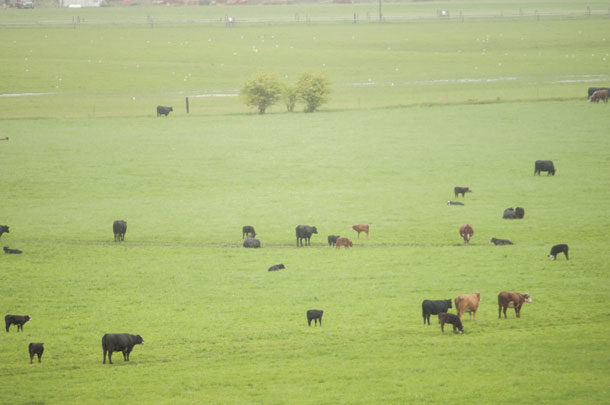If you are like most producers, rainfall is your greatest limiting factor. You have no control over when or how much you will receive. However, through proper management, you can improve your opportunities to capture and store rainfall when it comes – and not necessarily in a rain barrel.
Many factors determine what happens to the rainfall you receive. Some primary factors include:
- The type, quantity and density of vegetative cover
- Storm intensity and duration
- Soil moisture prior to the rainfall event
- Soil water-holding capacity
- Slope
These factors affect how much water evaporates, infiltrates (the rate at which water enters the soil) and moves through the vegetation, as well as the amount and velocity of runoff that may erode the soil surface.
Maintain vegetative cover to protect soil
Well-managed, healthy pastures and rangeland have adequate vegetative cover to protect the soil from raindrop impact, promote infiltration and slow any runoff to minimize erosion. These pastures are able to capture rainfall so it can be used to grow forage for livestock production and wildlife habitat.
Typically, degraded and unhealthy rangeland and pastureland has lost its most productive soil and soil organic matter, which results in poor soil structure, reduced infiltration rates and a lower water-holding capacity. This is most often caused by overgrazing for an extensive period of time.
To help improve the amount of water for your soils and plants, begin monitoring forage stubble heights. Record the average vegetation height prior to and after grazing the pasture. A good rule of thumb for stubble height in introduced pastures is 3 to 4 inches and 6 to 8 inches for rangeland.
Leaving adequate stubble height protects the soil surface from raindrop impact, promotes infiltration, and allows plants to remain healthy and productive. Taking the time to monitor and record vegetation measurements will help you maintain healthy pastures and capture the rain when it comes. The key is to maintain adequate vegetative cover to protect the soil and promote infiltration.
Develop a grazing management plan
Proper grazing management is the key to maintaining proper forage stubble heights. By utilizing a grazing plan and setting proper stocking rates, you can manage stubble height in your pastures and rangeland. This will keep them in good condition and able to capture and store rainfall received.
In order to do this, you will need to have a monitoring plan. Start by keeping rainfall records to help you evaluate seasonal and year-to-date amounts relative to past years’ rainfall amounts. If you are going into the growing season with below-normal rainfall or are in the growing season with below-normal rainfall, you can adjust stocking rates accordingly.
It is also important to monitor the vegetation in each of your pastures. A simple method is to use a grazing stick (yardstick) and measure the forage height at several locations across the pasture prior to rotating livestock into the pasture. Take the measurements at average sites in the pasture, not at the most or least productive sites.
With this information, you can more easily predict how much forage you should have grown or will grow by the end of the growing season in order to adjust your stocking rate accordingly or to utilize forage in other ways, such as with another class of animal, prescribed fire, stockpiling, etc.
Once you have determined the average height, continue to monitor the vegetation once grazing occurs. Remember the “take half, leave half” rule of thumb, and don’t graze more than half of the leaf. The green leaf is the “solar panel” that produces the plant’s food, which is stored in the root system. If less than half of the leaf material is removed, the plant can regrow its leaves without harming the root system. Of equal importance, take half, leave half helps ensure there is enough forage stubble height in your pastures to effectively capture the rainfall that Mother Nature provides. This is a basic concept that is critically important to proper land stewardship and your profitability. ![]()
PHOTO: Manage your grazing impact and expand capacity so that available rainfall is maximized for pasture resources. Staff photo.

-
Brian Hays
- Pasture and Range Consultant
- Noble Research Institute
- Email Brian Hays








